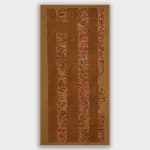

Tiwanako/Huari
Stylised Tunic Panel, Circa. 800AD
Camelid fibres
119 x 51 cm
47 x 20 in
UK
47 x 20 in
UK
HUA0021
Copyright of Paul Hughes Fine Arts
This wonderful drawn and almost complete half tunic was created so acutely stylised and abstracted that the staff bearing figures are almost unrecognisable, perhaps in a deliberate attempt by the...
This wonderful drawn and almost complete half tunic was created so acutely stylised and abstracted that the staff bearing figures are almost unrecognisable, perhaps in a deliberate attempt by the elite to monopolise their interpretation. Abstract figures distorted almost beyond recognition may also be an attempt to represent the shamanic transformation and drug-induced trance consciousness which were part of Wari religious ceremonies. In the Wari and Tiwanaku civilisations, images from stone carvings were repeated, abstracted, compressed, and expanded, emphasising the rectilinear and thus imperial power and its ability to order the world. The pattern on this tunic, a profile face with a vertical split eye and crossed fangs, and an inverted stepped fret motif, is a unique Wari design.
This work has been digitally enhanced to show post conservation an image pre digitally enhanced is available upon request.
This work has been digitally enhanced to show post conservation an image pre digitally enhanced is available upon request.

